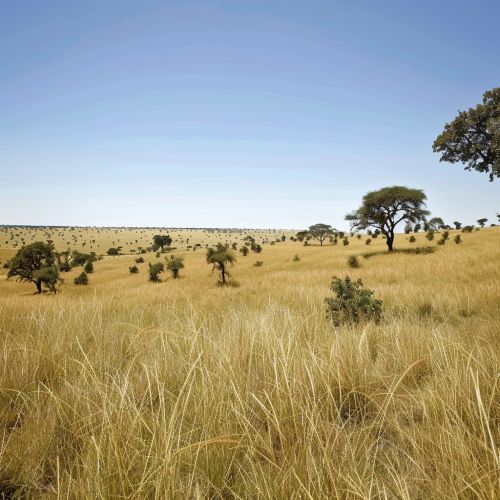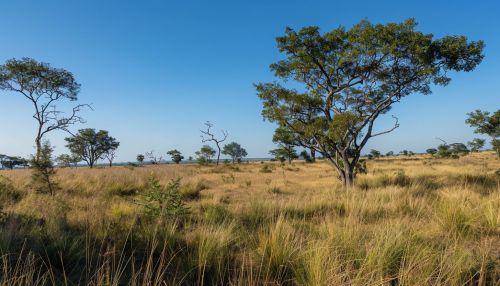Savannas
Introduction
Savannas are a type of grassland ecosystem characterized by the trees being sufficiently small or widely spaced so that the canopy does not close. This allows sufficient light to reach the ground to support an unbroken herbaceous layer consisting primarily of grasses. Savannas are typically found in regions where there is a distinct dry season and a wet season, which influences the types of flora and fauna that can thrive in these environments. They are most commonly found in Africa, but also occur in South America, Australia, and India.
Characteristics of Savannas
Savannas are defined by their unique combination of grasses and trees. The balance between these two types of vegetation is influenced by several factors, including climate, soil, and disturbances such as fire and grazing. The grasses in savannas are typically C4 plants, which are adapted to high temperatures and intense sunlight. These grasses are highly efficient at photosynthesis and can thrive in conditions where water is limited.
The trees in savannas are often deciduous, shedding their leaves during the dry season to conserve water. Common tree species include Acacia, Baobab, and Eucalyptus. These trees are adapted to survive in environments with limited water availability and frequent fires. Their deep root systems allow them to access water stored deep in the soil, while their thick bark provides protection against fire.


Climate and Soil
Savannas are typically found in regions with a tropical or subtropical climate. These regions experience a distinct wet and dry season, with the majority of the annual rainfall occurring during the wet season. The dry season can last for several months, during which time the grasses and trees must be able to survive with little to no water.
The soil in savannas is often nutrient-poor and well-drained. This is due to the high rate of decomposition and the leaching of nutrients during the wet season. The grasses in savannas have adapted to these conditions by developing extensive root systems that can quickly absorb nutrients and water when they become available.
Flora and Fauna
The flora and fauna of savannas are highly adapted to the unique conditions of this ecosystem. The grasses and trees are adapted to survive in environments with limited water availability and frequent fires. The animals in savannas are also adapted to these conditions, with many species being migratory and able to travel long distances in search of food and water.
Flora
The dominant vegetation in savannas is grasses, which can grow up to several meters tall. These grasses are highly efficient at photosynthesis and can quickly recover after being grazed or burned. Common grass species include Themeda triandra, Panicum maximum, and Hyparrhenia rufa.
The trees in savannas are often scattered and widely spaced, allowing sufficient light to reach the ground to support the growth of grasses. Common tree species include Acacia, Baobab, and Eucalyptus. These trees are adapted to survive in environments with limited water availability and frequent fires.
Fauna
The fauna of savannas is highly diverse and includes a wide range of herbivores, carnivores, and omnivores. Common herbivores include zebras, wildebeest, and elephants. These animals are adapted to travel long distances in search of food and water and can survive on a diet of grasses and leaves.
Carnivores in savannas include lions, cheetahs, and hyenas. These animals are adapted to hunt and scavenge for food in an environment where prey is often scarce. Omnivores, such as baboons and warthogs, are also common in savannas and are able to survive on a diet of both plant and animal matter.
Ecological Processes
Savannas are dynamic ecosystems that are shaped by a variety of ecological processes. These processes include fire, grazing, and nutrient cycling. Each of these processes plays a crucial role in maintaining the balance between grasses and trees in savannas.
Fire
Fire is a natural and important part of the savanna ecosystem. It helps to control the growth of trees and shrubs, allowing grasses to thrive. Fire also helps to recycle nutrients back into the soil, promoting the growth of new vegetation. Many species of grasses and trees in savannas have adapted to survive and even thrive after being burned.
Grazing
Grazing by herbivores is another important ecological process in savannas. Herbivores help to control the growth of grasses and shrubs, preventing them from becoming too dense and shading out other vegetation. Grazing also helps to promote the growth of new vegetation by stimulating the production of new shoots and leaves.
Nutrient Cycling
Nutrient cycling is the process by which nutrients are recycled back into the soil. This process is essential for maintaining the fertility of the soil and promoting the growth of new vegetation. In savannas, nutrient cycling is facilitated by the decomposition of plant and animal matter, as well as by the action of fire and grazing.
Human Impact
Human activities have had a significant impact on savannas. These activities include agriculture, deforestation, and climate change. Each of these activities has the potential to alter the balance between grasses and trees in savannas, with potentially serious consequences for the flora and fauna that depend on this ecosystem.
Agriculture
Agriculture is one of the primary human activities that impact savannas. The conversion of savannas to agricultural land can lead to the loss of native vegetation and the disruption of ecological processes such as fire and grazing. This can result in a decline in biodiversity and the degradation of the soil.
Deforestation
Deforestation is another major threat to savannas. The removal of trees can lead to the loss of habitat for many species of flora and fauna, as well as the disruption of ecological processes such as nutrient cycling. Deforestation can also contribute to soil erosion and the loss of soil fertility.
Climate Change
Climate change is expected to have a significant impact on savannas. Changes in temperature and precipitation patterns can alter the balance between grasses and trees, with potentially serious consequences for the flora and fauna that depend on this ecosystem. Climate change can also exacerbate the effects of other human activities, such as agriculture and deforestation.
Conservation
Conservation efforts are essential for protecting savannas and the flora and fauna that depend on this ecosystem. These efforts include the establishment of protected areas, the promotion of sustainable land use practices, and the restoration of degraded savannas.
Protected Areas
The establishment of protected areas is one of the most effective ways to conserve savannas. Protected areas provide a refuge for native species and help to preserve the ecological processes that are essential for maintaining the balance between grasses and trees. Examples of protected areas in savannas include national parks and wildlife reserves.
Sustainable Land Use
Promoting sustainable land use practices is another important aspect of savanna conservation. This includes practices such as rotational grazing, agroforestry, and the use of fire management techniques. These practices can help to maintain the balance between grasses and trees, while also providing benefits for local communities.
Restoration
Restoration efforts are also essential for conserving savannas. This includes activities such as reforestation, the reintroduction of native species, and the restoration of degraded soils. Restoration efforts can help to restore the balance between grasses and trees, as well as promote the recovery of native flora and fauna.
See Also
- Grassland
- C4 plants
- Deciduous
- Acacia
- Baobab
- Eucalyptus
- Zebra
- Wildebeest
- Elephant
- Lion
- Cheetah
- Hyena
- Baboon
- Warthog
- Fire ecology
- Nutrient cycling
- Deforestation
- Climate change
- Agroforestry
